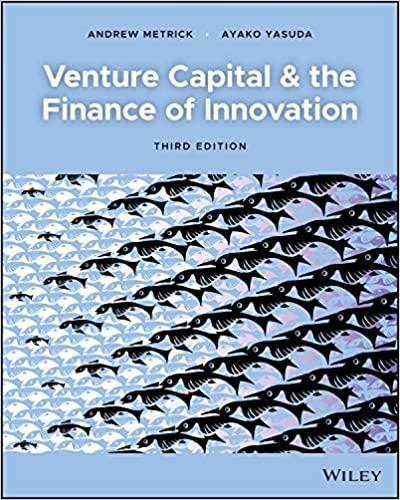Largeco pension plan begins investing in VC funds in 2010. They commit to a few new funds
Question:
Largeco pension plan begins investing in VC funds in 2010. They commit to a few new funds every year. They compute returns to their VC portfolio by adding the cash flows they receive and the reported company values from all their funds. In 2020, the Chief Investment Officer of Largco (you!) asks for a report on Largco's VC performance over the prior 10 years. The head of the VC team estimates the following CAPM regression:
![]() where Rt is the realized quarterly return on the VC portfolio, Rft represents the risk‐free rate for borrowing and lending, Rmt is the realized return on the market portfolio, β (beta) is the regression slope coefficient, α (alpha) is the regression intercept, and eit is the regression error term. All variables are measured quarterly with time periods given by t. The regression produces statistically significant estimates of β = 0.75 and α = 7.50 (annualized), with an R2 of 0.32. Members of your staff—Albert, Bonnie, Chris, Dave, and Ellen—raise several concerns with these results. As the Chief Investment Officer, you must evaluate these concerns. Which ones (if any) are valid? Which ones (if any) are invalid? For the valid concerns, is there any possible fix?
where Rt is the realized quarterly return on the VC portfolio, Rft represents the risk‐free rate for borrowing and lending, Rmt is the realized return on the market portfolio, β (beta) is the regression slope coefficient, α (alpha) is the regression intercept, and eit is the regression error term. All variables are measured quarterly with time periods given by t. The regression produces statistically significant estimates of β = 0.75 and α = 7.50 (annualized), with an R2 of 0.32. Members of your staff—Albert, Bonnie, Chris, Dave, and Ellen—raise several concerns with these results. As the Chief Investment Officer, you must evaluate these concerns. Which ones (if any) are valid? Which ones (if any) are invalid? For the valid concerns, is there any possible fix?
a. Al thinks that the estimated alpha is too high because of survivor bias.
b. Bonnie thinks that the estimated beta is too low because of a stale value problem.
c. Chris thinks that this model does not properly adjust for the high probability of failure for VC investments.
d. Dave thinks that this model does not properly adjust for the illiquidity of VC investments.
e. Ellen thinks something else is wrong, but she can't put her finger on it.
Step by Step Answer:

Venture Capital And The Finance Of Innovation
ISBN: 9781119490111
3rd Edition
Authors: Andrew Metrick, Ayako Yasuda





